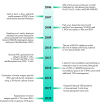Neoantigen Specific T Cells Derived From T Cell-Derived Induced Pluripotent Stem Cells for the Treatment of Hepatocellular Carcinoma: Potential and Challenges
- PMID: 34054880
- PMCID: PMC8155510
- DOI: 10.3389/fimmu.2021.690565
Neoantigen Specific T Cells Derived From T Cell-Derived Induced Pluripotent Stem Cells for the Treatment of Hepatocellular Carcinoma: Potential and Challenges
Abstract
Immunotherapy has become an indispensable part of the comprehensive treatment of hepatocellular carcinoma (HCC). Immunotherapy has proven effective in patients with early HCC, advanced HCC, or HCC recurrence after liver transplantation. Clinically, the most commonly used immunotherapy is immune checkpoint inhibition using monoclonal antibodies, such as CTLA-4 and PD-1. However, it cannot fundamentally solve the problems of a weakened immune system and inactivation of immune cells involved in killing tumor cells. T cells can express tumor antigen-recognizing T cell receptors (TCRs) or chimeric antigen receptors (CARs) on the cell surface through gene editing to improve the specificity and responsiveness of immune cells. According to previous studies, TCR-T cell therapy is significantly better than CAR-T cell therapy in the treatment of solid tumors and is one of the most promising immune cell therapies for solid tumors so far. However, its application in the treatment of HCC is still being researched. Technological advancements in induction and redifferentiation of induced pluripotent stem cells (iPSCs) allow us to use T cells to induce T cell-derived iPSCs (T-iPSCs) and then differentiate them into TCR-T cells. This has allowed a convenient strategy to study HCC models and explore optimal treatment strategies. This review gives an overview of the major advances in the development of protocols to generate neoantigen-specific TCR-T cells from T-iPSCs. We will also discuss their potential and challenges in the treatment of HCC.
Keywords: T cell receptors; T cell-derived induced pluripotent stem cells; T cells; hepatocellular carcinoma; immunotherapy; neoantigen.
Copyright © 2021 Lu, Ma, Jin, Luo and Li.
Conflict of interest statement
The authors declare that the research was conducted in the absence of any commercial or financial relationships that could be construed as a potential conflict of interest.
Figures




Similar articles
-
Chimeric antigen receptor-engineered T-cell therapy for liver cancer.Hepatobiliary Pancreat Dis Int. 2018 Aug;17(4):301-309. doi: 10.1016/j.hbpd.2018.05.005. Epub 2018 May 24. Hepatobiliary Pancreat Dis Int. 2018. PMID: 29861325 Review.
-
Current Landscape of Adoptive Cell Therapy and Challenge to Develop "Off-The-Shelf" Therapy for Hepatocellular Carcinoma.J Gastroenterol Hepatol. 2025 Apr;40(4):791-807. doi: 10.1111/jgh.16872. Epub 2025 Jan 26. J Gastroenterol Hepatol. 2025. PMID: 39865534 Review.
-
Persistent Polyfunctional Chimeric Antigen Receptor T Cells That Target Glypican 3 Eliminate Orthotopic Hepatocellular Carcinomas in Mice.Gastroenterology. 2020 Jun;158(8):2250-2265.e20. doi: 10.1053/j.gastro.2020.02.011. Epub 2020 Feb 12. Gastroenterology. 2020. PMID: 32060001 Free PMC article.
-
Shed antigen-induced blocking effect on CAR-T cells targeting Glypican-3 in Hepatocellular Carcinoma.J Immunother Cancer. 2021 Apr;9(4):e001875. doi: 10.1136/jitc-2020-001875. J Immunother Cancer. 2021. PMID: 33833049 Free PMC article.
-
Chimeric Antigen Receptor (CAR)-T Cells: A New Era for Hepatocellular Carcinoma Treatment.J Biochem Mol Toxicol. 2024 Dec;38(12):e70091. doi: 10.1002/jbt.70091. J Biochem Mol Toxicol. 2024. PMID: 39664011 Review.
Cited by
-
Immunotherapy for Pediatric Acute Lymphoblastic Leukemia: Recent Advances and Future Perspectives.Front Immunol. 2022 Jun 13;13:921894. doi: 10.3389/fimmu.2022.921894. eCollection 2022. Front Immunol. 2022. PMID: 35769486 Free PMC article. Review.
-
Single-cell landscape of dynamic changes in CD8+ T cells, CD4+ T cells and exhausted T cells in hepatocellular carcinoma.Sci Rep. 2025 Feb 3;15(1):4130. doi: 10.1038/s41598-025-88377-7. Sci Rep. 2025. PMID: 39900964 Free PMC article.
-
Neoantigens and their clinical applications in human gastrointestinal cancers.World J Surg Oncol. 2022 Sep 29;20(1):321. doi: 10.1186/s12957-022-02776-y. World J Surg Oncol. 2022. PMID: 36171610 Free PMC article. Review.
-
Exploring the promising potential of induced pluripotent stem cells in cancer research and therapy.Mol Cancer. 2023 Nov 28;22(1):189. doi: 10.1186/s12943-023-01873-0. Mol Cancer. 2023. PMID: 38017433 Free PMC article. Review.
-
Personalized neoantigen vaccine combined with PD-1 blockade increases CD8+ tissue-resident memory T-cell infiltration in preclinical hepatocellular carcinoma models.J Immunother Cancer. 2022 Sep;10(9):e004389. doi: 10.1136/jitc-2021-004389. J Immunother Cancer. 2022. PMID: 36113894 Free PMC article.
References
Publication types
MeSH terms
Substances
LinkOut - more resources
Full Text Sources
Other Literature Sources
Medical

